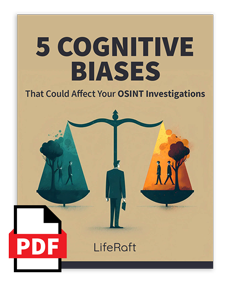Effective social media intelligence gathering has become a pillar of any proactive threat detection program. Users upload terabytes of content to the web every minute. That provides an enormous bounty of data for corporate security teams to identify vulnerabilities, track public sentiment, and spot potential risks.
But in practice, it’s not so easy. With so much data out there, it can be challenging to even know where to start. And without the right techniques, analysts could overlook threats to their organization that are hiding right in plain sight.
In this blog post, we outline seven tips that will help you gather more effective social media intelligence and provide valuable insights for your security operations.
Whether you are a seasoned analyst or a beginner, these tips will help you streamline your collection process and enhance your overall business intelligence capabilities.
So, let's get started!
7 Tips for More Effective Social Media Intelligence Gathering
- Cast a wide net for data collection
- Cover your digital footprint
- Keep up with the social media landscape
- Don’t piggyback off of the marketing department
- Employ both active and passive intelligence gathering
- Get creative with keyword queries
- Document all findings
Learn More: How to Use OSINT to Safeguard Your Company’s Reputation Online
1. Cast a wide net for data collection
 While many security teams focus their social media surveillance efforts on well-known platforms like Facebook, Instagram, Twitter, and TikTok, analysts are encountering new challenges as alternative networks continue to gain popularity. Threat actors are becoming increasingly sophisticated and may post on lesser-known sites to evade detection. That can leave teams vulnerable to threats that were right in front of them the whole time.
While many security teams focus their social media surveillance efforts on well-known platforms like Facebook, Instagram, Twitter, and TikTok, analysts are encountering new challenges as alternative networks continue to gain popularity. Threat actors are becoming increasingly sophisticated and may post on lesser-known sites to evade detection. That can leave teams vulnerable to threats that were right in front of them the whole time.
To address this issue, analysts must broaden their social media monitoring beyond the standard platforms that come to mind and include less familiar sites in their scope of coverage. This can help to minimize the risk of overlooking critical threats that could pose a serious risk to an organization's security.
2. Cover your digital footprint
 As you browse the internet, you leave behind a trail of digital breadcrumbs. This includes information such as your IP address, keyboard configurations, and operating system. Although many people may share similar hardware and settings, the compilation of your distinct online behavior can create a unique fingerprint that reveals a lot about your identity and intentions. For analysts, this can pose a problem as their cyber fingerprints could potentially alert a person of interest that they are being investigated. This could prompt them to hide their activities by destroying evidence or retaliating against your organization.
As you browse the internet, you leave behind a trail of digital breadcrumbs. This includes information such as your IP address, keyboard configurations, and operating system. Although many people may share similar hardware and settings, the compilation of your distinct online behavior can create a unique fingerprint that reveals a lot about your identity and intentions. For analysts, this can pose a problem as their cyber fingerprints could potentially alert a person of interest that they are being investigated. This could prompt them to hide their activities by destroying evidence or retaliating against your organization.
To mitigate this risk, take steps to protect your operational security by conducting investigations on a virtual machine with a privacy-focused browser connected to the web through a VPN. We also recommend using a managed attribution service that can conceal your online activity from third parties. By doing so, you can conduct investigations with greater anonymity and reduce the likelihood of alerting potential adversaries.
3. Keep up with the social media landscape
Over time, new social networks appear while others vanish. While it may not be considered a core function of their job, security teams must keep track of these shifts in the online media landscape. For instance, after the January 6th Capitol riots, users moved to an alt-tech social network called Parler. More recently following Elon Musk’s purchase of Twitter, hundreds of thousands of users abandoned the microblogging service for rivals like Mastodon. Analysts must keep up with these changes to avoid monitoring inactive or unhelpful sites.
4. Don’t piggyback off of the marketing department
Some security teams may be tempted to use the same social media monitoring tools as their marketing colleagues to cut costs. This approach, however, creates two potential issues. Firstly, the tools made for marketing purposes generally take a considerable amount of time to retrieve data from various online sources. Although this may not pose a significant problem for creating new campaigns or public relations work, it can be a costly delay during crisis situations that demand swift action. Secondly, these tools typically concentrate only on major networks, disregarding alternative, smaller sites. To avoid these drawbacks, managers should explore security-specific tools with rapid crawl times and broad coverage.
5. Employ both active and passive intelligence gathering
Analyzing the massive amounts of data posted on the internet every day requires a combination of active and passive intelligence gathering approaches. Active collection is quicker but costly and challenging to scale. Meanwhile, passive collection covers more ground, but the data may become outdated, and important threat signals could be missed.
To achieve optimal results, it's crucial to find a balance between these two techniques. Social media monitoring tools can aid in passive collection. Still, it's necessary for analysts to occasionally browse through these online communities manually to gain an understanding of the language and threat level they pose.
6. Get creative with keyword queries

Simply searching for frequently-used words such as "terrorism" or "kill" when creating search queries is insufficient. Those with malicious intent are aware that authorities scan for these terms, so they exploit alternative phrases to evade detection. Analysts must be knowledgeable of these obfuscation methods and watch out for them.
Moreover, people on alternative platforms now share more multimedia content like videos, images, and audio clips. Unfortunately, many monitoring tools find it challenging to identify non-textual content. It's vital not to overlook a lack of search outcomes, as a keyword search returning no results doesn't necessarily mean that critical information doesn't exist.
7. Document all findings

Novice analysts tend to overlook recording crucial information, such as dates, URLs, and timestamps, while conducting investigations. This can lead to a lack of important data during the analysis stage of the intelligence process, resulting in the need to revisit and retrieve lost details. However, the internet is an erratic environment, and what is available today could be gone tomorrow. This is particularly true on alternative social networks where data is short-lived.
To avoid this issue, it's essential to document all findings and details during an investigation. This can be accomplished manually or by utilizing various free or paid tools. Regardless of the approach, proper documentation will save time and avoid frustration in the long run.
The bottom line on social media intelligence gathering
Social media intelligence gathering is an indispensable aspect of any modern security team. The ability to monitor, analyze, and react to the rapidly evolving digital landscape is critical to success in today's fast-paced world. By following the seven tips outlined in this article, professionals can improve their social media intelligence gathering capabilities and stay ahead of emerging threats.
Remember, effective social media intelligence is not just a matter of using the right tools. It requires a strategic mindset, a commitment to ongoing improvement, and a willingness to adapt to new challenges as they arise. With the right approach and a willingness to learn, anyone can become a more effective social media intelligence analyst and make a meaningful impact in their field.


